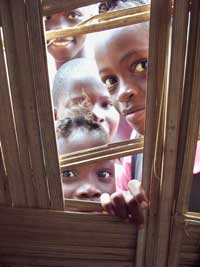
Leading a STM Medical Team
Late Pre-Trip Tasks
Team Meetings

Purpose of meetings
Team meetings serve several functions: the dissemination of information;
team training in the medical processes
to be carried out on the trip; getting to know one another; and getting to know the host country/culture, among others.
While some of these could be done by email or phone, there is something about meeting face to face, having
informal discussions before or after the meeting, praying together, and sharing our stories, fears, and expectations
that brings a team together in a way that cannot be duplicated by meeting for the first time in the field.
These relational links are key to successfully navigating the difficult waters when the unexpected stresses that
bear upon a team appear. The value of face-to-face meetings is that these allow, more than any other
method, the development of a shared attitude of the heart amongst team members.
Number of meetings
The size of the team and the length of the trip will dictate the number of meetings. Between three and six
meetings of two or three hours are generally recommended. The last meeting is usually 7 to 14 days prior to departure,
with other meetings spaced before that meeting at two- to three-week intervals.
Topics to cover
Sample agendas for team meetings prior to a trip to Peru are available from the outline below. Notice as you look through the agendas that some items of
great import are repeated from one meeting to another. The exact order of presentation of most items is not critical;
however these items must be covered at some point:
- Purpose of trip
- Our attitude = learner/servant
- Daily work schedule
- Where we'll stay
- What we'll eat
- How we'll get around
- Preparing for the medical work
- Emergency contact list for family back home
- Detailed flight information
- Baggage rules
- Finances - how much and when it is due
- Sample packing list
- Passport information
- Visa information
- Individual testimonies
- Country and culture information
- Culture entry model
- SFINC
- Photography of locals?
- Dress code
- Code of conduct
- Security concerns
- Money and cash to bring
- Shopping
- Language
- What about gifts?
Devotions
Meetings always open and close with prayer. If the group is comfortable with praying in a group, closing with a
time of group prayer can be meaningful. A short devotion follows the opening prayer. There are several texts that are
helpful in helping people meditate upon a giving, compassionate, humble heart, a heart that is open to the leading of
God, and upon the model of Jesus in ministry. See the links below for examples.
Getting to know one another
Getting to know one another is done via the sharing of testimonies - a short time of each individual
telling about their faith journey. More than any other activity, this one brings teams together, especially if the
leader sets the tone of honesty and transparency by sharing first. Hearing of one another's struggles cannot help
but give us a more tender and forgiving heart once we are in the field. Do not skimp on the time required for
this activity.
Getting to know the host country
Getting to know the country to which you are traveling is a pleasure and helps with the entry into the culture.
Assign various team members the task of giving a mini-report (three to five minutes in length) about a particular area that interests them:
- History
- Economy
- Religion
- Geography
- People
- Culture
- Food
Preparation for medical work
Naturally, these meetings can be used to prepare the team members for the various medical, dental or nursing
tasks that form the basis of the medical ministry. The medical and nursing directors will need to handle this part of
things and the amount of time needed will vary widely depending upon the nature of the trip.

Gumby has become a wonderful visual aid in learning about missions and has been a mascot on each of our trips. Gumby is: always Smiling, Flexible, can Improvise, and Never Complains. The acronym, SFINC, is often heard during the trip! See the link below for more info and ordering information.
Logistic information to share
Meetings are a perfect forum for disseminating administrative information about the trip: finances, schedules,
passports, visas, packing lists, luggage rules, letters of support, a team covenant (code of conduct), etc.
See links below for some sample meeting agendas and other forms.
Cultural know-how
Team meetings are a great time to present information that will help
each team member feel more comfortable in a new culture and will help prevent inadvertent cultural blunders. Answers to
these questions should be addressed with your national host:
- What common greetings are used?
- Do people greet one another with handshakes? Hugs? Kisses?
- Does that apply to men meeting men, women meeting women, or men meeting women?
- What can you tell us about the dress code?
- What is your advice about gifts?
- Appropriateness, size, for whom, when to give it, etc.
- Appropriateness, size, for whom, when to give it, etc.
- What can you advise regarding the photography of local people?
Culture entry preparation
It's helpful to prepare your team for the emotional
reaction that is common among affluent westerners
entering a developing country for the first time. Spending time in the last or next-to-last meeting with the
Cultural Entry Model has been useful in mitigating some of the emotions inherent in seeing a new and different
culture. See the link below for the model we have used.
Downloads available
- Agendas
- Devotions
- Other
- How To Run A Meeting article
- Team Covenant (Code of Conduct)
- Gumby handout
- Web source for Gumby (mini)
- Sample Packing List
- Sample Prayer Letter
- Sample Support Letter
- Culture Entry Model
- MD and RN fanny pack contents
- US State Department International Travel web site
- CDC Travelers' Health web site
- Example of County Immunization Clinic
| «Previous Page | Next Page» |